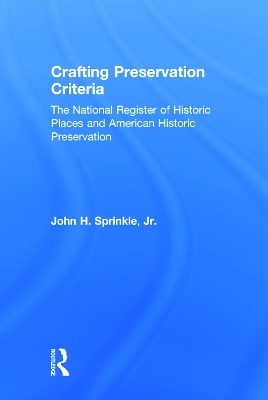
Crafting Preservation Criteria
The National Register of Historic Places and American Historic Preservation
Seiten
2014
Routledge (Verlag)
978-0-415-64255-2 (ISBN)
Routledge (Verlag)
978-0-415-64255-2 (ISBN)
In 1966, American historic preservation was transformed by the passage of the National Historic Preservation Act, which created a National Register of Historic Places. Now comprising more than 1.4 million historic properties across the country, the National Register is the official federal list of places in the United States thought to be worthy of preservation.
One of the fundamental principles of the National Register is that every property is evaluated according to a standard set of criteria that provide the framework for understanding why a property is significant in American history. The origins of these criteria are important because they provide the threshold for consideration by a broad range of federal preservation programs, from planning for continued adaptive use, to eligibility for grants, and inclusion in heritage tourism and educational programs.
Crafting Preservation Criteria sets out these preservation criteria for students, explaining how they got added to the equation, and elucidating the test cases that allowed for their use. From artworks to churches, from 'the fifty year rule' to 'the historic scene', students will learn how places have been historically evaluated to be placed on the National Register, and how the criteria evolved over time.
One of the fundamental principles of the National Register is that every property is evaluated according to a standard set of criteria that provide the framework for understanding why a property is significant in American history. The origins of these criteria are important because they provide the threshold for consideration by a broad range of federal preservation programs, from planning for continued adaptive use, to eligibility for grants, and inclusion in heritage tourism and educational programs.
Crafting Preservation Criteria sets out these preservation criteria for students, explaining how they got added to the equation, and elucidating the test cases that allowed for their use. From artworks to churches, from 'the fifty year rule' to 'the historic scene', students will learn how places have been historically evaluated to be placed on the National Register, and how the criteria evolved over time.
John H. Sprinkle, Jr. is a Historian at the National Park Service in Washington, D.C. He teaches courses on historic preservation at the University of Maryland, George Mason University, and Northern Virginia Community College.
Introduction
Chapter 1: Prehistory of Preservation
Chapter 2: An Orderly, Baanced, and Comprehensive Panorama
Chapter 3: Integrity and Authenticity
Chapter 4: Both Artistic and Historic
Chapter 5: A More Difficult Problem
Chapter 6: The 50 Year Rule
Chapter 7: Separation of Historic Church and State
Chapter 8: Le Tout Ensemble
Chapter 9: The Preservation Movement
Chapter 10: Eligible for Inclusion
| Erscheint lt. Verlag | 21.2.2014 |
|---|---|
| Zusatzinfo | 15 Halftones, black and white |
| Verlagsort | London |
| Sprache | englisch |
| Maße | 152 x 229 mm |
| Gewicht | 453 g |
| Themenwelt | Kunst / Musik / Theater |
| Geisteswissenschaften ► Geschichte ► Geschichtstheorie / Historik | |
| Geisteswissenschaften ► Geschichte ► Hilfswissenschaften | |
| Geisteswissenschaften ► Geschichte ► Regional- / Ländergeschichte | |
| ISBN-10 | 0-415-64255-8 / 0415642558 |
| ISBN-13 | 978-0-415-64255-2 / 9780415642552 |
| Zustand | Neuware |
| Haben Sie eine Frage zum Produkt? |
Mehr entdecken
aus dem Bereich
aus dem Bereich
Russland, die Ukraine und der Westen
Buch | Softcover (2024)
De Gruyter (Verlag)
CHF 55,90
Geschichte und Theorie
Buch | Softcover (2024)
De Gruyter Oldenbourg (Verlag)
CHF 34,90
wie Irritationen historisches Denken anregen
Buch | Softcover (2024)
Kohlhammer (Verlag)
CHF 96,55


